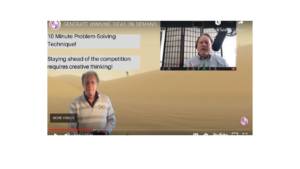GENERATE WINNING IDEAS ON DEMAND
 Bloomer Boomer editor and video game enthusiast Andy Asher brings a modern way of viewing life, learning and sharing with his community of people over 55 . He is a thinker, a biker, athlete, grandpa, adventurer, thought leader and partner who explores modern life with friends and followers over 55. Follow Andy on YouTube, Facebook, Twitter and other social media platforms.
Bloomer Boomer editor and video game enthusiast Andy Asher brings a modern way of viewing life, learning and sharing with his community of people over 55 . He is a thinker, a biker, athlete, grandpa, adventurer, thought leader and partner who explores modern life with friends and followers over 55. Follow Andy on YouTube, Facebook, Twitter and other social media platforms.
CREATE IN A FLASH: A Leader’s Recipe For Breakthrough Innovation, by innovation and creativity expert Roger L. Firestien, PhD 100 Ideas In 10 Minutes Is Possible With Deliberate Problem-Solving Technique Staying ahead of the competition requires creative thinking, and the ability to create ideas on demand. , illustrates how to cultivate creativity personally, and how to lead a team to produce breakthrough results. Firestien, senior faculty member at the Center for Creativity and Change Leadership at SUNY Buffalo, teaches a proven method for deliberate creativity – the Creative Problem-Solving process (CPS). It has been used to invent new products, save millions of business dollars, effect social change and even save lives. Using CPS, it is possible to generate a hundred ideas in as little as 10 minutes, significantly increasing the odds of producing winning solutions. In fact, research has shown that groups trained in CPS are capable of producing ideas at over double the rate of untrained groups. “Innovative thinking is not something that can be mandated or delegated, so leaders must first develop their own creative ability before leading their organizations to create breakthroughs,” says Firestien. The Creative Problem-Solving process is a simple, repeatable technique that has been used by organizations large and small to solve seemingly intractable problems. It employs both divergent and convergent thinking to generate many possibilities and then select the best ideas to put into action. The process consists of four distinct steps: STEP 1: CLARIFY THE PROBLEM Identify a goal or challenge, then generate ways to redefine the problem and choose the best problem to solve STEP 2: GENERATE IDEAS Generate ideas for solving the problem, then select the best ones to refine and develop STEP 3: DEVELOP SOLUTIONS Ideas have become solutions, evaluate and refine them. STEP 4: PLAN FOR ACTION Generate all the potential actions to put the solution into action, then choose the best actions to implement the solution CPS is not just about generating ideas. It is also about clearly identifying the best problem to solve. Leaders in organizations often loathe spending time clarifying the problem. “Invest the time to identify the true problem,” says Firestien “…it does no good to generate ideas for solving the wrong problem.” When he facilitates a CPS session, often half of the time is spent identifying what the real problem is. The remaining time is spent generating ideas, developing solutions and planning for action. CPS sometimes uses a technique called Forced Connections that helps increase imaginative thinking by combining ideas that don’t appear to be related in a new way. This method helps get ideas flowing when stuck. The technique is very simple: first, consider the problem. Then pick an object or situation that is completely unrelated. Next, find or “force” a connection between the problem and the seemingly unrelated object. The result of this new connection is a new idea. Firestien relays a story of General Motors applying Creative Problem-Solving in one of its plants. Machines that were used to stamp out parts were malfunctioning and destroying the product. The cost for GM replacing the parts was $50,000 a week. After convening a CPS session that consisted of workers trained in CPS, the breakthrough solution, which was inspired by the cooking product Pam®, was to use a simple mixture of oil and soap in a spray bottle. The total cost was $1.50 and 40 minutes of staff time. A $50,000 problem had been solved with a $1.50 solution. Illustrated with many stories about creative problem solving in action, CREATE IN A FLASH is for leaders who know that in order to competition-proof their businesses and future-proof their lives, they need to be able to deliberately create winning ideas on demand. # # # About The Author Roger L. Firestien, PhD, has trained more people to lead the creative process than anyone else in the world. He is senior faculty at the Center for Creativity and Change Leadership at SUNY Buffalo State and president of Innovation Resources, Inc. For more information, please visit www.RogerFirestien.com.
Category: Blog



































